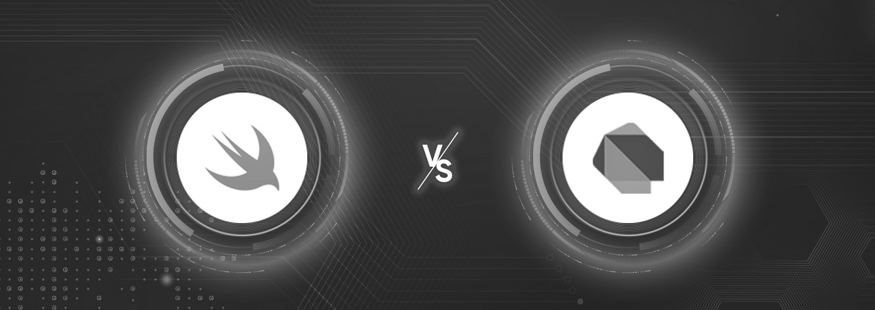Quick Summary
Swift versus Dart—a battle defining the future of programming. The two rising stars spark a heated debate on the most potent language for modern development.
Swift, the brainchild of Apple, has revolutionized iOS app development with its speed, safety, and ease of use. Meanwhile, Dart, championed by Google, has emerged as a versatile language for building web and mobile applications, known for its flexibility and scalability.
In this blog, we’ll dive deep into the features, functionalities, and applications of the two programming languages. Whether for mobile app creation or web development, understanding the nuances between Swift and Dart is essential for making informed coding choices. Let’s dive in.
Understanding Swift
Apple’s Swift, launched in 2014, is a free and open-source programming language for developing iOS apps. It became more popular rapidly than Objective-C, the previous standard for creating iOS apps.
Swift’s interactive programming approach facilitates rapid and efficient code creation. The extensive documentation is another plus, making it more accessible to programmers. While mobile app development is where Swift shines, desktop and online app development are also viable options. Developers may take advantage of Swift’s portability by using it on several platforms.
Key Features:
- Swift prioritizes safety, minimizing errors with optional and memory management features for more reliable code.
- User-friendly syntax resembles natural language, making code easier to understand, write, and maintain.
- Known for its speed and efficiency, Swift delivers excellent performance crucial for resource-intensive applications.
- Swift Playgrounds provides an interactive space for experimenting and testing code snippets, aiding learning and rapid prototyping.
- Being open-source encourages collaboration and innovation, fostering a robust developer community and contributing to its evolution.
- Swift works well with Objective-C, enabling a smooth transition while leveraging existing codebases.
Understanding Dart
Dart is an object-oriented programming language. It is widely used to develop mobile applications, modern web applications, desktop applications, and the Internet of Things (IoT) applications using the Flutter framework.
Since the release of its foundational framework, Flutter, the Dart programming language has seen explosive growth in its user base. Already a leader among mobile app development frameworks, the Dart application UI kit has impressed the industry.
Key Features:
- Dart employs an object-oriented programming approach, enabling developers to create reusable and structured code components.
- Dart utilizes both Just-In-Time (JIT) for faster development and Ahead-Of-Time (AOT) for optimized performance in production.
- Dart offers static typing for safer code and reduced errors, alongside type inference to streamline code without sacrificing clarity.
- Dart’s async/await mechanism facilitates efficient asynchronous programming, crucial for responsive applications.
- Dart incorporates garbage collection for automatic memory management, minimizing memory-related issues.
- Dart’s extensive array of open-source libraries makes creating aesthetically beautiful and feature-rich apps easy.
Head-to-Head Comparison
Let’s compare the two programming languages, taking into account the benefits and drawbacks of each.
Syntax and Structure: How Swift and Dart Differ
Swift: Known for its clean and expressive syntax, Swift is beginner-friendly. It employs options, type inference, and concise code structure, simplifying complex tasks like handling options and string manipulation.
Dart: Dart offers a familiar syntax for those experienced in Java or JavaScript. Dart’s syntax is straightforward and easily readable.
Difference: Swift uses more natural and concise codes, making it easier for newbies to learn. On the other hand, Dart’s familiarity with languages like JAVA makes it easier for them to switch over and start using it.
Performance and Speed Benchmarks
Swift: Renowned for its high performance and efficiency, Swift excels in handling
memory management and speed. It’s optimized for Apple platforms, offering excellent performance, especially in resource-intensive tasks like gaming or multimedia applications.
Dart: Dart’s performance is noteworthy, particularly its use in Flutter, which offers impressive speed and smooth UI rendering.
Difference: Swift often shines in Apple-centric environments due to its optimization for iOS and macOS. Dart’s performance, especially within the Flutter framework, is competitive and robust, catering to cross-platform development needs.
Community Support
Swift: Backed by Apple, Swift offers strong support for regular updates and a dedicated developer community. Its ecosystem includes a range of libraries and frameworks for iOS, macOS, watchOS, and tvOS development.
Dart: Less extensive than other languages, Dart’s community contributes libraries, packages, and tools, particularly focused on mobile and web development.
Difference: Swift’s ecosystem is more mature and extensive, given its backing by Apple and longer presence. Fueled by Flutter’s popularity, Dart’s ecosystem is rapidly expanding, especially in cross-platform mobile app development.
Scalability
Swift: Swift programs are compact and light in terms of file size. For this reason, native applications built using Swift provide the best possible experience for their users.
Dart: Dart apps are big and thirsty for resources. These applications tend to be larger since the development engine does not let the app size decrease below a specified amount.
Difference: Swift’s scalability is highly tailored to Apple’s ecosystem, excelling in that domain. Dart’s scalability is broader, extending across multiple platforms and benefiting from Flutter’s cross-platform capabilities, enabling scalability across various operating systems.
Swift VS Dart: What’s the Verdict?
When to Pick Swift-
- Ideal for Apple’s ecosystem: iOS, macOS, watchOS, and tvOS.
- Leverages Apple’s robust frameworks and tools.
- Prioritizes efficiency and optimization for Apple devices.
- Long-standing language with a substantial user base and extensive documentation.
- Suited for those familiar with Apple’s coding environments and procedures.
When to Pick Dart–
- Suitable for hybrid app development: iOS, Android, and web platforms.
- Excellent for crafting sophisticated UIs using Flutter.
- Offers advanced features like async/await and high concurrency alongside its clear syntax.
- Compiles for multiple platforms, supporting cross-platform development.
- Freely available with a thriving community focused on continuous improvement.
Final Thoughts
In the quest for the ideal programming language, the choice between Swift and Dart depends on specific project requirements and target platforms.
Swift is the go-to language for a strong foothold in Apple’s ecosystem and optimized performance on Apple devices. On the other hand, Dart shines in its versatility for cross-platform development, particularly excelling with Flutter’s UI capabilities.
The key is to align your choice with the demands of your project, ensuring a smooth and successful coding journey.
Our team of professionals is here to help you navigate this decision and provide expert guidance tailored to your needs. Contact us today to choose the right programming language for your development endeavors.






